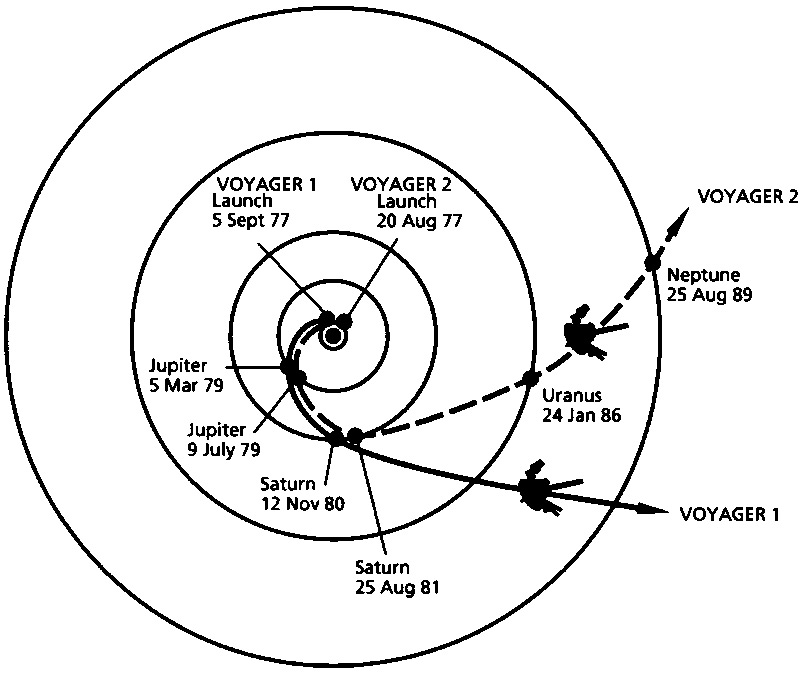Today’s space history segment combines the recent past and the long past.
In the recent past, 35 years ago today — September 5, 1977 — the Voyager 1 space probe launched from Cape Canaveral aboard a Titan IIIE-Centaur rocket.

(Conceptual drawing of the region of space around our solar system, with the two Voyager spacecraft. NASA image.)
Like its sister ship, Voyager 2 (launched about 2 weeks prior), Voyager 1 was designed to study Jupiter and Saturn. Voyager 1’s trajectory was such that it reached both planets before Voyager 2. After its Saturn encounter in 1980, Voyager 1 began making its way toward the edge of the solar system.
Voyager 1 is speeding away from the Sun at a velocity of about 3.50 AU/year toward a point in the sky of RA= 262 degrees, Dec=+12 degrees (35.55 degrees ecliptic latitude, 260.78 degrees ecliptic longitude). Late on 17 February 1998, Voyager 1 became the most distant man-made object from the Sun, surpassing the distance of Pioneer 10.
According to this June 14, 2012, NASA news release,
Data from NASA’s Voyager 1 spacecraft indicate that the venerable deep-space explorer has encountered a region in space where the intensity of charged particles from beyond our solar system has markedly increased. Voyager scientists looking at this rapid rise draw closer to an inevitable but historic conclusion – that humanity’s first emissary to interstellar space is on the edge of our solar system.
“The laws of physics say that someday Voyager will become the first human-made object to enter interstellar space, but we still do not know exactly when that someday will be,” said Ed Stone, Voyager project scientist at the California Institute of Technology in Pasadena. “The latest data indicate that we are clearly in a new region where things are changing more quickly. It is very exciting. We are approaching the solar system’s frontier.”
Very cool.
In the long past, on September 5, 1857 — Old Style, that is; it would actually be September 17 on the New Style calendar — Konstantin E. Tsiolkovskiy was born in Russia. The greatest early theorist of space travel, in 1903 he published an article in Nauchnoye Obozreniye (Science Review) that he originally submitted in 1898. Entitled “Investigating Space With Rocket Devices,” the paper “presented years of calculations and laid out many of the principles of modern spaceflight.”
In the 1920s and 1930s, Tsiolkovskiy proved especially productive, publishing ten major works clarifying the nature of bodies in orbit, developing scientific principles behind reaction vehicles, designing orbital space stations, and promoting interplanetary travel. He also expanded the scope of studies on many principles commonly used in rockets today: specific impulse to gauge engine performance, multistage boosters, fuel mixtures such as liquid hydrogen and liquid oxygen, the problems and possibilities inherent in microgravity, the promise of solar power, and spacesuits for extravehicular activity. Significantly, he never had the resources—perhaps not even the inclination—to experiment with rockets himself.
Even though the coincidence of dates is pure artifice — the product of changes to the world’s calendars — it seems a fitting coincidence. After all, the Voyager mission itself was presaged by Tsiolkovskiy’s original work.













